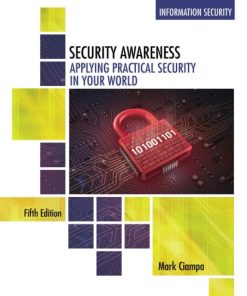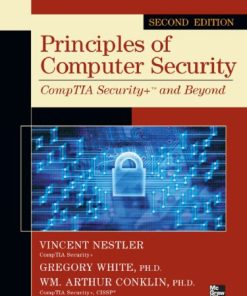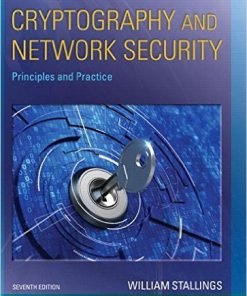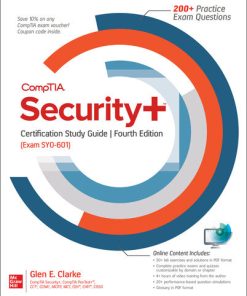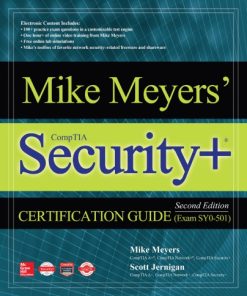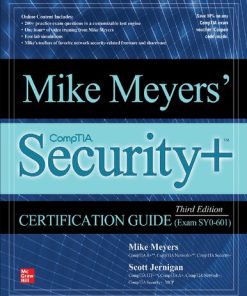(EBook PDF) Comptia Security Guide to Network Security Fundamentals 7th Edition by Mark Ciampa 9798214340357 full chapters
$50.00 Original price was: $50.00.$25.00Current price is: $25.00.
Comptia Security+ Guide to Network Security Fundamentals 7th Edition by Mark Ciampa 9798214340357 – Ebook PDF Instant Download/DeliveryISBN:
Full download Comptia Security+ Guide to Network Security Fundamentals 7th Edition after payment.
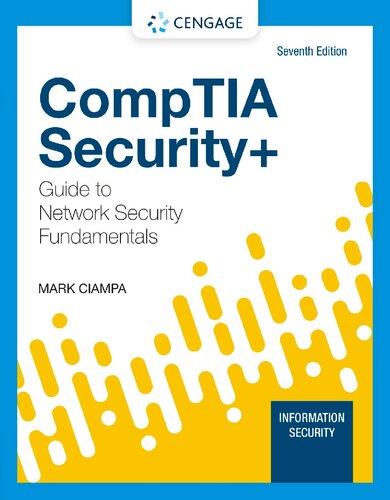
Product details:
ISBN-13 : 9798214340357
Author: Mark Ciampa
Mapped to the new CompTIA Security+ SY0-601 Certification Exam, best-selling COMPTIA SECURITY+ GUIDE TO NETWORK SECURITY FUNDAMENTALS, Seventh Edition, thoroughly prepares readers for professional certification and career success. The text covers threats, attacks and vulnerabilities; defensive architectures and designs; security implementations; operations and incident response; and governance, risk and compliance. It also includes expansive coverage of security assessments, threat hunting, penetration testing and cloud security, and the latest developments and trends in information security, including new software tools to assess security and implement protections. New Hands-On Projects, case activities and virtual online cybersecurity lab exercises help readers put what they learn into practice, while end-of-chapter exercises direct them to the Information Security Community Site for up-to-the-minute news and insight from the cybersecurity field.
Comptia Security+ Guide to Network Security Fundamentals 7th Table of contents:
Part 1. Security Fundamentals
Module 1. Introduction to Security
What Is Information Security?
Understanding Security
Defining Information Security
Who Are the Threat Actors?
Script Kiddies
Hacktivists
State Actors
Insiders
Other Threat Actors
Vulnerabilities and Attacks
Vulnerabilities
Attack Vectors
Social Engineering Attacks
Impacts of Attacks
Summary
Key Terms
Review Questions
Hands-On Projects
Case Projects
Module 2. Threat Management and Cybersecurity Resources
Penetration Testing
Defining Penetration Testing
Why Conduct a Test?
Who Should Perform the Test?
Rules of Engagement
Performing a Penetration Test
Vulnerability Scanning
What Is a Vulnerability Scan?
Conducting a Vulnerability Scan
Data Management Tools
Threat Hunting
Cybersecurity Resources
Frameworks
Regulations
Legislation
Standards
Benchmarks/Secure Configuration Guides
Information Sources
Summary
Key Terms
Review Questions
Hands-On Projects
Case Projects
Part 2. Endpoint Security
Module 3. Threats and Attacks on Endpoints
Attacks Using Malware
Imprison
Launch
Snoop
Deceive
Evade
Application Attacks
Scripting
Injection
Request Forgery
Replay
Attacks on Software
Adversarial Artificial Intelligence Attacks
What Are Artificial Intelligence (AI) and Machine Learning (ML)?
Uses in Cybersecurity
Risks in Using AI and ML in Cybersecurity
Summary
Key Terms
Review Questions
Hands-On Projects
Case Projects
Module 4. Endpoint and Application Development Security
Threat Intelligence Sources
Categories of Sources
Sources of Threat Intelligence
Securing Endpoint Computers
Confirm Boot Integrity
Protect Endpoints
Harden Endpoints
Creating and Deploying SecDevOps
Application Development Concepts
Secure Coding Techniques
Code Testing
Summary
Key Terms
Review Questions
Hands-On Projects
Case Projects
Module 5. Mobile, Embedded, and Specialized Device Security
Securing Mobile Devices
Introduction to Mobile Devices
Mobile Device Risks
Protecting Mobile Devices
Embedded Systems and Specialized Devices
Types of Devices
Security Issues
Summary
Key Terms
Review Questions
Hands-On Projects
Case Projects
Part 3. Cryptography
Module 6. Basic Cryptography
Defining Cryptography
What Is Cryptography?
Cryptography Use Cases
Limitations of Cryptography
Cryptographic Algorithms
Hash Algorithms
Symmetric Cryptographic Algorithms
Asymmetric Cryptographic Algorithms
Cryptographic Attacks and Defenses
Attacks on Cryptography
Quantum Cryptographic Defenses
Using Cryptography
Encryption through Software
Hardware Encryption
Blockchain
Summary
Key Terms
Review Questions
Hands-On Projects
Case Projects
Module 7. Public Key Infrastructure and Cryptographic Protocols
Digital Certificates
Defining Digital Certificates
Managing Digital Certificates
Types of Digital Certificates
Public Key Infrastructure (PKI)
What Is Public Key Infrastructure (PKI)?
Trust Models
Managing PKI
Key Management
Cryptographic Protocols
Secure Sockets Layer (SSL)
Transport Layer Security (TLS)
Secure Shell (SSH)
Hypertext Transport Protocol Secure (HTTPS)
Secure/Multipurpose Internet Mail Extensions (S/MIME)
Secure Real-time Transport Protocol (SRTP)
IP Security (IPsec)
Weaknesses of Cryptographic Protocols
Implementing Cryptography
Key Strength
Secret Algorithms
Block Cipher Modes of Operation
Crypto Service Providers
Summary
Key Terms
Review Questions
Hands-On Projects
Case Projects
Part 4. Network Security
Module 8. Networking Threats, Assessments, and Defenses
Attacks on Networks
Interception Attacks
Layer 2 Attacks
DNS Attacks
Distributed Denial of Service Attack
Malicious Coding and Scripting Attacks
Tools for Assessment and Defense
Network Reconnaissance and Discovery Tools
Linux File Manipulation Tools
Scripting Tools
Packet Capture and Replay Tools
Physical Security Controls
External Perimeter Defenses
Internal Physical Security Controls
Computer Hardware Security
Summary
Key Terms
Review Questions
Hands-On Projects
Case Projects
Module 9. Network Security Appliances and Technologies
Security Appliances
Firewalls
Proxy Servers
Deception Instruments
Intrusion Detection and Prevention Systems
Network Hardware Security Modules
Configuration Management
Security Technologies
Access Technologies
Technologies for Monitoring and Managing
Design Technologies
Summary
Key Terms
Review Questions
Hands-On Projects
Case Projects
Module 10. Cloud and Virtualization Security
Cloud Security
Introduction to Cloud Computing
Securing Cloud Computing
Virtualization Security
Defining Virtualization
Infrastructure as Code
Security Concerns for Virtual Environments
Secure Network Protocols
Simple Network Management Protocol (SNMP)
Domain Name System Security Extensions (DNSSEC)
File Transfer Protocol (FTP)
Lightweight Directory Access Protocol (LDAP)
Internet Protocol Version 6 (IPv6)
Use Cases
Summary
Key Terms
Review Questions
Hands-On Projects
Case Projects
Module 11. Wireless Network Security
Wireless Attacks
Bluetooth Attacks
Near Field Communication (NFC) Attacks
Radio Frequency Identification (RFID) Attacks
Wireless Local Area Network Attacks
Vulnerabilities of WLAN Security
Wired Equivalent Privacy
Wi-Fi Protected Setup
MAC Address Filtering
Wi-Fi Protected Access (WPA)
Wireless Security Solutions
Wi-Fi Protected Access 2 (WPA2)
Wi-Fi Protected Access 3 (WPA3)
Additional Wireless Security Protections
Installation
Configuration
Specialized Systems Communications
Summary
Key Terms
Review Questions
Hands-On Projects
Case Projects
Part 5. Enterprise Security
Module 12. Authentication
Types of Authentication Credentials
Something You Know: Passwords
Something You Have: Smartphone and Security Keys
Something You Are: Biometrics
Something You Do: Behavioral Biometrics
Authentication Solutions
Password Security
Secure Authentication Technologies
Summary
Key Terms
Review Questions
Hands-On Projects
Case Projects
Module 13. Incident Preparation, Response, and Investigation
Incident Preparation
Reasons for Cybersecurity Incidents
Preparing for an Incident
Incident Response
Use SOAR Runbooks and Playbooks
Perform Containment
Make Configuration Changes
Incident Investigation
Data Sources
Digital Forensics
Summary
Key Terms
Review Questions
Hands-On Projects
Case Projects
Module 14. Cybersecurity Resilience
Business Continuity
Introduction to Business Continuity
Resilience through Redundancy
Policies
Definition of a Policy
Types of Security Policies
Summary
Key Terms
Review Questions
Hands-On Projects
Case Projects
Module 15. Risk Management and Data Privacy
Managing Risk
Defining Risk
Risk Types
Risk Analysis
Risk Management
Data Privacy
User Concerns
Data Breach Consequences
Data Types
Protecting Data
Data Destruction
Summary
Key Terms
People also search for Comptia Security+ Guide to Network Security Fundamentals 7th:
comptia security+ description
is comptia security+ for beginners
comptia security+ requirements
comptia security+ how much
comptia security+ guide to network security fundamentals 6th edition
Tags:
Comptia Security,Network Security,Fundamentals,Mark Ciampa
You may also like…
Computers - Security
Security Awareness: Applying Practical Security in Your World 5th Edition Mark Ciampa
Computers - Security
Principles of Computer Security: CompTIA Security+ and Beyond 2nd edition
Computers - Computer Certification & Training
Uncategorized
eTextbook 978-0134444284 Cryptography and Network Security: Principles and Practice (7th Edition)
Computers - Networking
Computers - Computer Certification & Training
Mike Meyers’ CompTIA Security+ Certification Guide, Second Edition (Exam SY0-501) Mike Meyers
Computers - Computer Certification & Training
Mike Meyers’ CompTIA Security+ Certification Guide Third Edition (Exam SY0-601)
Computers - Security




